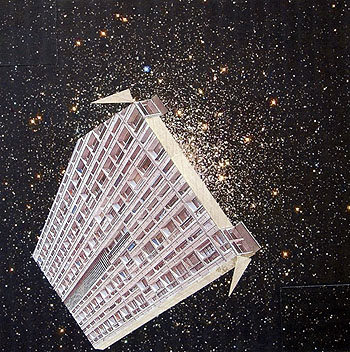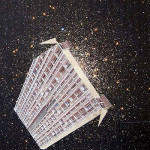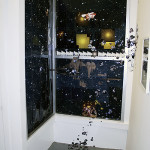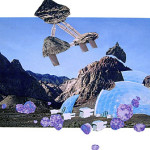By BRUCE CAMPBELL
Architecture has been on many people's minds lately; well due to speculation that the economy could possibly maybe be in a light recession due to the past half decade's gluttonous housing bubble, I'd say architecture in some form or another is on just about everyone's mind. Todd Keyser's exhibition of collages, painting and installation at Rebekah Templeton Contemporary Art evidences that he too has been contemplating the recent and not so recent promises and failures of architecture as a literal panacea to crumbling social structures.
The Truth About Maximilian consists mainly of modestly sized collages of found and altered digital imagery that merge mid-20th Century architectural fragments with nebula-filled star-scapes or barren sci-fi landscapes à la Classic Star Trek. So what bearing do fifty-year-old buildings mashed up with nostalgic sci-fi imagery have on today?
During the 1950's and 60's architectural theory coupled with advancing construction techniques allowing our experience with the built world to conquer the fear of and catch up to the previous decades' fascination with the promise of science to radically transform society through pure knowledge. Applied technology would give mankind deity-like power to control all aspects of life and to live in a utopian world of efficiency and convenience (and to boot we could all stop worrying about what to wear as the ubiquitous silver jumpsuit would soon be in style forever!).
Obviously none of this came to pass. Sure, contemporary living is unimaginably intertwined with technology but many people still wonder: Where is my flying car? Simply put, we feel cheated and a bit jaded.
The connection to today is that there seems to be a half-hearted attempt to, if not outright repeat, then recapture that glowing sense of optimism and destiny that propelled the United States to the Moon in less than ten years! Several years ago President Bush weakly commanded that NASA get back to the moon (taking a little under 20 years this go around) and possibly more successfully, current Presidential candidate Barack Obama promotes idealistic 60's style concepts such as Hope, Peace, and Change while press reports casting him as a “Kennedy-esque” figure are trumpeted often. Each of these acts is tinged with longing for past successes. Keyser's inoffensive and fun collages, utilize the signifiers of past hopes to question the reliance on past structures that have either failed to result in the promised world or failed to adapt to a changing world that is more complex than previously thought.
Keyser's most ambitious and layered work is a collage installation in the gallery's front window titled Chrome and Matter. A loose grid of repeated black and blue-hued star-scapes fill the interior view of two 6 by 3 foot windows meeting on a corner. The left window is a sparsely populated black vacuum with a few satellites and some apparently condo-conversion asteroids; these gravitate together as you approach the corner transition to the more active right window. Due to the preexisting architecture and Keyser's smart placement of outer-spacey items, the window is highly evocative of Marcel Duchamp's Large Glass. The only object not floating and drifting amongst the stars is a red, square-edged rock outcropping anchoring the center base of the composition. Terra-formed asteroids and structures bob around, and eventually through, large eroded stalagmite and stalactite formations that are reminiscent in placement and formation to Duchamp's bachelors. Just along the mid-frame of the window, what seem to be shuttle nose-cones repeat and race from left to right slamming into the wall causing an explosion of asteroids to break the frame of the window and drift onto the adjacent wall. Completing the upper half are two densely populated yellow star fields that end as abruptly as the paper they are printed on while a shuttle rises in its launch arc over the entire diorama. Even as the shuttle offers metaphors of hope and advancement it's cargo bay is bursting with a pessimistic and deadly viral load.
Chrome and Matter allows for more interpretive and complex readings of issues related to questionable uses of biology, the housing crunch, and secluded populations, than the smaller collages, which comment individually on each of the themes available (Orange Craft Mutations, Last Available Pod, and the hilariously titled Bucky's Layer, respectfully). The successes of the small collages, which can become visually repetitive due to the limited source material (although I assume this is a conscious choice by Keyser, reflecting the similarly limited forms expressed by both architecture and art of the period), is to be found when the juxtaposition of elements is left simple. When he does so, such as in the nicely paired End of Growth Period and Bloom the issues addressed come to the forefront. Each take what are essentially two elements, Keyser's enlarged purple space bacteria and some slightly altered concrete and glass structures, to deftly suggest, respectfully, urban design restrictions and technological integration of past structures.
Ironically, this strategy works against Keyser when utilized in the paintings present. Each of these panels replicates an element from the colleges swimming in flat monochrome color fields, suggestive of little more than themselves. The most interesting, Maximilian, presents two large buildings hovering in the foreground as a blue and white comet and its' tail slowly cross the maroon tinted space; ultimately it feels cartoonish and lonely. Similar in composition but opposite in effect, the small, uncomplicated Craft presents a thin wall of a building seemingly ready to leap into space; a galactic center peaks out from behind the building's base. The multiple possible uses of this work's title in relation to the ideas concerning a built society lend an optimistic feeling to the void in depicts. Keyser's work subtly reminds us that there are still major issues to be dealt with that arose from both the concrete and cultural structures developed over the past half-century or more, and furthermore, questions if our desire for new and perhaps more realistic, rewarding structures is enough to produce a truly forward thinking society rather than one that lives through the past in the future.
- Todd Keyser, Craft, collage and painting, 2008.
- Todd Keyser, Chrome and Matter, installation, 2008.
- Todd Keyser, Keyser’s Layer, collage and painting, 2008
Rebekah Templeton Contemporary Art
"The Truth About Maximillion" is on view until April 19th at Rebekah Templeton Contemporary Art located at 173 Girard Ave., in Philadelphia
All images are courtesy of the artist and Rebekah Templeton Contemporary Art.







